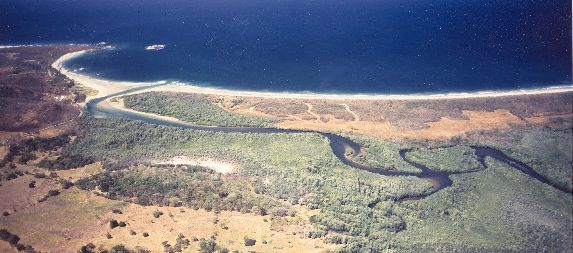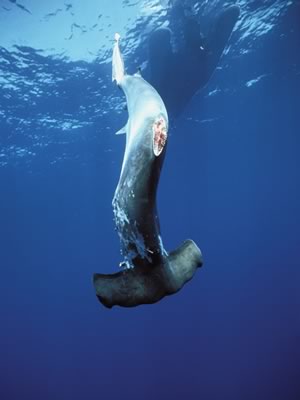Sea turtles, whales and sharks
Sea turtles
Costa Rica's seas and beaches are visited by some five species of sea turtles: Olive Ridley Turtle (Lepidochelys olivacea), Hawksbill Turtle (Eretmochelys imbricata), Green Turtle (Chelonia mydas), Loggerhead Turtle (Caretta caretta) and the Leatherback Turtle (Dermochelys coariacea). All five species are on Costa Rica's list of fauna in danger of extinction (Decree 26435- MINAE 1997) containing 17 birdspecies, 13 species of mammals, 2 amphibians and 8 species of reptiles, in total 40 species. IUCN also lists these sea turtles as threatened with extinction.



The last mentioned species, the Leatherback Turtle (tortuga baula), worldwide numbers only an estimated 30,000 of which there are some 3,000 left of the Eastern Pacific subspecies. Over the past 20 years, their numbers have plummeted more than 90%. The most important nesting beaches for these turtles in the American continent are in Costa Rica, Playa Grande, Playa Ventanas and Playa Langosta, all three in the Las Baulas National Marine Park near the tourist town Tamarindo, Guanacaste, created by Decree in 1991 and by Law in 1995.


Unfortunately, before and after the creation of the park, mainly foreign but also national land speculators purchased hundreds of lots in and near the park. Largely due to pressure by the costarican ngo PRETOMA (www.pretoma.org) who collected 7,685 petition signatures, Costa Rica's President Oscar Arias signed in October 2007 32 decrees calling for expropriation of lots behind the beaches. In 2008, developers proposed changes to the boundaries of the park but these have been rejected by the Environmental Committee of Costa Rica's Congress. On 14 January, 2009, the Constitutional Court of Costa Rica (the so-called Sala IV) determined that the properties within the park area do not meet the environmental criteria, prohibited to issue any further construction permits and ordered the Government to continue the expropriation procedures.
In May, 2009 under pressure from developers, the Oscar Arias Government proposed to change the boundaries of the park and downgrade part of it to a national wildlife refuge, thus allowing for certain development and halting the expropriations. Many national authorities and organisations such as Fundación Neotrópica, FECON (http://feconcr.org), la Defensoría de los Habitantes, and international organisations such as the Leatherback Trust (www.leatherback.org), Red para la Conservación de Tortugas Marinas de Costa Rica (www.redtortugasmarinascr.org), the Rainforest of the Austrians (www.regenwald.at/de/home.html) and EALA have sharply protested against this proposal. In January, 2010 EALA wrote to the Committee to stress the importance of complying with international conventions regarding protected areas such as the Las Baulas Park, see Letter_Conventions.doc. On 31st October 2014, the Tribunal Contencioso Administrativo declared invalid all landtitles of plots of land located within the maritime zone of 200 meters from the high tide line, a great victory for all environmentalists who have been acting against the commercial development of the beautiful and valuable beach of Playa Grande.



The Olive Ridley Turtle (tortuga lora o carpintera) see foto below, is the smallest species, about 70 cm. Every year between October and February, up to one million of these turtles arrive at the beaches of Ostional and Nancite in Guanacaste to lay their eggs, a phenomenon called "arribada", a most spectacular sight. Primarily at these beaches, and at a beach in Escobilla, Mexico and the Gahirmatha beach, Kendrapada disctrict, state Orissa in India, these turtles lay their eggs. The young ones hatch about three months later. Sadly, at the beach in India until recently some 800,000 turtles arrived each year but lately extensive jelly fish catch for Chinese markets is threathening to starve the Olive Ridley turtles.
_small.jpg)
.jpg)
Whales
Fundación Keto provides a good overview of the 29 species of whales and dolphins visiting Costa Rica's seas: www.fundacionketo.org/en/cetaceos-costa-rica.shtml. Examples of whales are Humpback Whale (Northern Hemisphere and Southern Hemisphere), Sperm Whale, Orca and False Killer Whale. Dolphins occurring in Costa Rica waters are Common Dolphin, Bottlenose Dolphin, Spinner Dolphin, etc.
One of the threats to the whales is the use of sonar by the US Navy causing each year beachings and death of certain whale species. Imagine that we human beings are exposed to such loud sound that we have no other way to escape the unbearable pain in our ears than to jump into a lake or sea and drown. In order to escape the loud booms bursting their eardrums, whales make their way to beaches. The National Resources Defense Council NRDC (www.nrdc.org) has at times succesfully challenged the Navy's practices and obtained court injunctions.
Another threat consists in collisions with ship.
Last but not least, obviously the whaling industry of Japan and other countries continues to impose threats for the survival of whales. In spite of many protests, in November 2007 Japan sent out a whaler to catch some 950 mink and fina whales and 50 humpback whales, a threathened species.



Sharks
Annually, more than 100 million sharks are killed mostly for their fins, which has caused the decimation of 90% of shark's worldwide population. In an extremely cruel practice, the animal is captured and its fins cut off, then the shark is thrown back into the water, bleeding and unable to swim, sinking to the bottom of the sea and dying a slow and agonizing death.
In Costa Rica sharks continue to be killed and their fins exported illegally to countries in Asia to meet the demand of the emerging middle class for the tasteless soup as proof of their social status. The film SHARKWATER (2003) highlights the practices in the town Puntarenas where sharkfins - without the body of the shark - are delivered by foreign fishing vessels to private docks although this is expressly forbidden. PRETOMA (www.pretoma.org) is taking legal action against Costa Rica's Institute for Fisheries and Agriculture INCOPESCA and other government institutions to try and stop this cruel, multimillion dollar business.
According to the well-known environmental action group Sea Shepherd headed by Captain Paul Watson (www.seashepherd.org), nowadays Brazil has become a great shark fin supplier to the Asian market.


